Today we travel to a future where darkness is a thing of the past.
Guests:
- Dr. John Barentine — director of public policy at the International Dark Sky Association
- Rebecca Boyle — science journalist
- Dr. Lucianne Walkowicz — astronomer at the Adler Planetarium
- Dr. Sara Pritchard — historian at Cornell University
Further Reading:
- What is light pollution?
- 80% of World Population Lives Under Skyglow, New Study Finds
- The end of night
- The Dark Side Of Light
- How you can help fight light pollution
- The Night Sky Will Never Be The Same
- Starlink press kit
- As SpaceX Launches 60 Starlink Satellites, Scientists See Threat to ‘Astronomy Itself’
- SpaceX says 12,000 satellites isn’t enough, so it might launch another 30,000
- How to spot the SpaceX Starlink satellite train overhead this week
- The man who turned night into day ← (Brian Merchant’s piece about Znamya)
- SpaceX will test making Starlink satellites less shiny to appease angry astronomers
- Elon Musk’s SpaceX has a plan to deploy up to 30,000 new satellites — and Morgan Stanley says it could cost as much as $60 billion
- Estimate of Starlink impact on different countries
- On (not) seeing artificial light at night: Light pollution or lighting poverty?
- The Trouble with Darkness: NASA’s Suomi Satellite Images of Earth at Night
- Epilogue. Field notes from the end of the world: Light, darkness, Energy, and endscape in polar night
Flash Forward is produced by me, Rose Eveleth. The intro music is by Asura and the outtro music is by Hussalonia. The episode art is by Matt Lubchansky. Special thanks to Thomas, Vera and Isaac Beckett who played the teacher and students in the intro this episode.
If you want to suggest a future we should take on, send us a note on Twitter, Facebook or by email at info@flashforwardpod.com. We love hearing your ideas! And if you think you’ve spotted one of the little references I’ve hidden in the episode, email us there too. If you’re right, I’ll send you something cool.
And if you want to support the show, there are a few ways you can do that too! Head to www.flashforwardpod.com/support for more about how to give. But if that’s not in the cards for you, you can head to iTunes and leave us a nice review or just tell your friends about us. Those things really do help.
That’s all for this future, come back next time and we’ll travel to a new one.
FULL TRANSCRIPT BELOW
▹▹ ▹▹ ▹▹ ▹▹ ▹▹ ▹▹ ▹▹ ▹▹ ▹▹ ▹▹ ▹▹ ▹▹ ▹▹ ▹▹ ▹▹ ▹▹ ▹▹ ▹▹ ▹▹ ▹▹ ▹▹ ▹▹ ▹▹
Rose: Hello and welcome to Flash Forward! I’m Rose and I’m your host. Flash Forward is a show about the future. Every episode we take on a specific possible… or not so possible future scenario. We always start with a little field trip into the future, to check out what’s going on, and then we teleport back to today to talk to experts about how that world that we just heard might really go down. Got it? Great!
This episode we’re starting in the year 2044.
***
[auditorium sounds, shuffling, mic noises]
Teacher: Okay next up we have Cynthia Selene presenting their project, “Reconstructing The History and Future of the Night Sky.” Cynthia, come on up.
[light applause]
Cynthia [nervous]: Hello. Thank you. My name is Cynthia Selene, and I would like to tell you a little bit about darkness. I started this project because I was interested in space. I would like to be an astronaut when I grow up, and explore the universe. When I was doing research about space, I learned that many past astronauts were inspired by the night sky. This was at first confusing to me, because the night sky is not that interesting, in my opinion. But then I learned that in the past, you used to be able to look up at the night sky, and see stars. Today, when we look up, we can only see the moon and the constellation satellites. They might seem like stars, but they’re not.
In my research, I also found photographs of what the night sky used to look like. Here is one of them. This is the Grand Canyon, and this isn’t a manipulated image, this is what it really looked like. Here, for comparison, is the Grand Canyon today.
As I was researching this, it made me really sad. I want to be able to see the stars, the real ones. So I would like to present to you my project, Reconstructing The History and Future of the Night Sky.
[typing sounds]
It turns out, today’s electrical grid tags all lighting nodes using the same piece of code. So with a bit of ingenuity we can…
[typing]
Bring back the night sky.
[sounds of the audience reacting to the lights going off]
Teacher: Cynthia, what did you just do?
Cynthia: If you don’t mind, please follow me in an orderly fashion outside. I made sure the Emergency Exit signs were not affected.
Teacher: Cynthia turn the lights back on.
Cynthia [nervous]: Um, just let’s go outside and see the sky…
[sound of people leaving]
Teacher: Please stay in your seats
[sound of us all going outsidee]
[General ooh’ing and aah’ing]
Cynthia: This is what the sky used to look like.
Person: What is that?
Cynthia: I believe that is the milky way.
[silence, general sounds of people being amazed]
Teacher: Cynthia, you only turned the lights off locally right?
Cynthia: Oh no, I turned them all off.
Teacher: All of them?
Cynthia: Yes!
Teacher: You can turn them back on, right?
Cynthia: Oh yes it’s very easy. Do you want me to do it now?
Teacher: ….soon.
Cynthia: Am I in trouble?
Teacher: Yes. Extremely.
Cynthia: … but did I get an A?
Teacher: [sighs] Yes, you get an A. Now go turn the lights back on.
Cynthia: Yes!
[fade out]
Rose: Okay, so, today we are talking about darkness, or really the lack of darkness. I’ve been thinking about doing this episode ever since I did the night vision episode last year. And in some ways, this is kind of the flip side of that episode — in case you missed it (I’ll link to it in the show notes), we talked about how having night vision might change our world. In that future, we wouldn’t really need lights anymore, because we could just see. And this future is the opposite, instead of returning to the darkness, we completely eradicate it.
Humans are on this path already. Since the invention of the lightbulb in the late 1800’s, wealthy developed nations have rapidly electrified and lit up.
John Barentine: The rate at which the world is lighting up at night is increasing pretty steadily.
Rose: This is Dr. John Barentine, the director of public policy for the International Dark Sky Association.
John: In the past decade, that rate was about 2 percent per year, on a global average basis, although there were certain countries where we were seeing double digit percentage increases year on year.
Rose: In the late 1990’s, when LED lightbulbs started taking off, people hoped that having these much brighter energy efficient lights would cut down on the number of lights installed around the world. But that’s not what happened. In fact, the current data suggests that with the money we’re saving on energy bills with these new lights, we’re just putting more lights in, rather than cutting down.
John: And if that’s true, it’s problematic not only for our cause, but also for all the people that have promoted energy efficient lighting. It means that the environmental benefits that were thought to come with that may not exist, and it may be doing more harm than good.
Rose: This is something that economists call the rebound effect, and you see it with city planning in other places too — it’s why widening highways doesn’t usually cut down on traffic. When you put in a new lane, more people drive their cars, and traffic stays the same.
And today, the glow of our artificial lights is almost ubiquitous, world wide.
There are lots of different ways you can measure the loss of darkness — you can look down on the Earth from space, and see all these little dots of light, and there is a very famous satellite image that does just that. Or if you don’t happen to have a satellite handy, you personally can look up at the sky from Earth, and look for something called sky glow.
John: if you look at your local night sky, and you look at the point directly overhead, which is called the zenith…
Rose: That spot, the zenith, is the darkest spot in the night sky. And if you look up at that spot, and there is measurable artificial light there, at that darkest possible place, that means you are living under skyglow — light that is bleeding out from our houses, buildings, streetlamps, cars, etc. And chances are, if you are listening to this podcast, you are most likely living under skyglow. 80 percent of the world, currently lives under a night sky that is contaminated with artificial light.
John: If you’re in North America or Europe, that figure is more approaching almost 99 percent of the population. Virtually everybody lives somewhere that there’s some light pollution.
Rose: And that’s the key term here, light pollution. And on today’s episode, we’re going to divide so-called light pollution into two categories. First, we’ll talk about light pollution here on the ground, and how it can impact our biology, our environment, and even our mental health. Then we’re going to talk about a different kind of light pollution — the way in which satellites can alter the night sky, and muck things up for astronomers who are trying to see through the darkness and out into the cosmos.
So let’s start with light pollution all around us — the lamps and the porch lights and the office buildings and all of that. All that light has an impact. It turns out, even from really early on in lighting’s history, scientists have noticed that our lights can confuse wildlife.
Rebecca Boyle: Migratory birds use the stars and the moon at night to navigate.
Rose: This is Rebecca Boyle, a science journalist who’s been covering the science of light pollution for a decade now.
Rebecca: And when there is a bright source of light that shouldn’t be there, they are drawn to it, and they are confused by it, and they circle around it, and they drop dead of exhaustion, literally.
Rose: There are papers about this phenomenon from Ornithology journals in the 1880’s, long before we got anywhere close to 80 percent of the world living under skyglow.
Rebecca: The earliest study I’ve ever found about this is an ornithologist studied a tower that was used for broadcasting radio and telegraph wires. And it was really bright, and he realized that these birds would be found on the ground around it, because they were drawn to the light.
Rose: And in the last ten years or so, research into light pollution research has really boomed. There are now lots, and lots of studies looking at how light impacts not just individual animals, but entire ecosystems.
Rebecca: It’s really counterintuitive to think of light as being a negative, but everything that we’ve looked at so far, every researcher who studied this, has found negative effects in pretty much every animal, and even plant, that exists on earth.
Rose: Research shows that artificial lights change migration patterns, they make songbirds lay their eggs early, and fish lay their eggs late. They make maple trees keep their leaves for longer, which can open them up to frost damage. One study found that house sparrows who are infected with West-Nile virus, and who also live in light polluted environments, are infectious for two days longer than those who live in darker areas. The paper that found this estimated that these extra two days increase the risk of a West Nile outbreak by 41 percent.
Sea turtles lay their eggs on beaches at night, and if there are lights on those beaches, they’ll avoid them, sometimes wandering onto roads nearby in search of a dark place to nest. And when those little turtle babies hatch, millions of years of evolution has conditioned them to navigate towards the sea by moving away from the dark, elevated land horizon line. When that line is lit up, they get confused and they go the wrong way.
The scientists who study light pollution have a tough job — they have to figure out what impacts are due to light, and which ones are due to other things that might come along with light like, people, pollution, traffic, noise, concrete, etc. And one of the ways that they’re doing that, is by studying a really dark, and really remote lake.
Rebecca: It’s really cool. This is in a lake… a freshwater lake in northern Germany. It’s about an hour and a half, by train, north of Berlin, in this beautiful natural reserve. Tall pine trees. Larch, a deciduous tree that’s common in Europe, are everywhere. It’s very bucolic, very peaceful. And this lake borders a former nuclear power plant.
Rose: Because it’s near this power plant, there’s actually a really big historical data set about the conditions at this lake, because scientists who ran the plant had to keep track of that stuff. And today, light pollution researchers are taking advantage of that historical data as a baseline.
Rebecca: So this team of researchers went to this lake. And they built this platform in the middle of the lake that streams light across the water, and down into the water. There are a whole series of tubes, kind of connecting together. And this looks like a spirograph, if you remember that toy from childhood where you draw a bunch of circles, that connect to each other. And each of them has a little ring of light that can turn on at night.
Rose: And what they’ve found is that pretty much every element of the lake is impacted by these lights — from the algae all the way up to the predators that live there. It’s not that everything dies, but the whole balance of the ecosystem is shifted. Some things did better, some things did worse, and the lake was fundamentally changed.
And what this means is that if humans continue lighting ourselves up at the rate we are, without changing anything about what those lights look like, and how they work, we’re going to see all kinds of weird ripple effects.
Rebecca: It’s obvious that there are changes happening. It’s sort of like climate change, where it’s just gonna be interesting to see how organisms adapt to this new environment. And some will definitely die. Some will definitely benefit. There’s one study that I have read a couple times, as I’m just fond of this paper, from a team of researchers in Scotland looking at shorebirds. And they found that this certain species of birds that live on the coast do really well when there’s a lot of light streaming from docks or, shipyards, or something, because they can forage a lot longer. And that’s a benefit to that species. But the fish that they’re preying on, they’re going to suffer because they’re going to get eaten more, you know. So it’s very complicated.
Rose: And it’s not just birds and turtles and plants, humans are also biological creatures, susceptible to some of these same impacts.
Rebecca: We have seen through epidemiology for the last 20 years that artificial light at night is related to obesity, depression, cancer, heart disease, even.
Rose: Okay, all the lightbulbs listening to this are probably going, “hey now lady, a little unfair are we?” Obviously, there’s a reason that the world is lighting up, at a rate of about 2.2 percent every year. Lights allow us to do lots of important things, like drive without hitting people or other cars, and walk down the street without tripping, and stay up late producing podcasts.
John: We have come to believe that all of this artificial light at night is good for our society.
Rose: That’s John Barentine, again.
John: And in certain respects, it is/ Because it enables us to extend the length of the day for purposes of commerce and activity and transportation and all of those things are useful for people, for our society.
Rose: And at the Dark Sky Association, where their goal is to protect the night sky, they have to balance the fact that light is both useful and sometimes damaging.
John: So, we’re not at all of the mind that the solution to this problem is turning the world’s lights off. That’s something I need to say right up front, because we don’t think that is a reasonable solution to this problem.
Rose: But at the same time, plowing ahead without doing anything differently is also probably a bad idea.
So, I’m going to be totally honest with you, when I first learned about light pollution, I remember having this sinking feeling. Like, oh my god, another thing I have to worry about? Another thing that we’re doing to screw up the Earth? How many things can I really care about and keep track of, honestly? Last episode we talked about warning fatigue, and this idea that you really do get tired of hearing about all the stuff that’s threatening you and the Earth.
And that’s very real. But! There’s something really cool about light pollution, or really about… fixing light pollution.
John: We’re lucky. It’s not like air pollution or water pollution, where you might stop the source of the pollution, but then you have to wait decades, or maybe longer than a human lifespan for the system to flush all of that pollutant out. The benefit that we have, that may be in other areas of environmental pollution work they don’t, is that there’s this potential for immediate gratification. It is absolutely a reversible situation, once people decide that they want it to be different.
Rebecca: That’s one reason why I actually like this as a subject and as a journalist, because it’s actually a really easy problem to solve. Unlike climate change, unlike, you know, pandemics — like we’re experiencing now — like this is something we can all do very little and have a big impact.
John: I like to say that this is the only environmental problem that can be solved at the speed of light.
Rose: You can, for example, change the lighting on your property. You can install motion sensors on your lights so those they only go on when someone’s there. You can put little hats on your lights, so that the light is directed down at the ground and not up into the sky. You can remove lights you don’t really need, and remember to turn lights off when you leave the room or go to bed.
Rebecca: There’s a fair amount you can do by yourself, and it can have real impact. It doesn’t necessarily require systemic change or government level changes to make a difference.
Rose: But if policy change is your thing, which it sort of should be, because that’s one of the big ways the world improves and we make better futures, you can petition your local governments to think about the lighting they’re installing or updating.
John: In the United States, for example, a lot of the public policy regarding outdoor lighting is made distinctly at the local level by individual municipalities
Rose: I recently looked into what my city is doing to mitigate light pollution, and I found out that Berkeley has a form you can fill out to request that your streetlights get updated with more energy friendly and light pollution friendly bulbs. So I’m gonna do that!
John: I believe, in my heart of hearts, that there is literally something that every individual person in the world can do to make this situation better, to help us decrease the amount of light pollution in the world. And the first step on that path is deciding that we want a different outcome. And that’s what I remain hopeful about, no matter what.
Rose: And he does kind of hope you’ll do that stuff soon, like now, because John worries that we might actually be running out of time to convince the world that this matters.
Rose [on the phone]: Do you ever fantasize about being able to switch lights off for a minute, for everyone to just see what it could be? “If I could only just show people the night sky, as it really could be, for one second, they would get it?”
John: I do, Rose. I think about that a lot. How can we convince people to care about something if they haven’t seen it themselves? If people grow up in a world, if the places where they live are places that you can’t see the stars now, because the light pollution is significant enough; how can we convince them to care enough about a resource to which they may never have had access? To want to do something about it? And to be honest, I think that’s the biggest challenge that my organization faces right now.
Rose: Looking at the night sky is something that humans have done for a really long time. I highly recommend it. If you haven’t recently, try spending some time looking at the sky. Even if you live in a really bright city, on most nights, you can still see some stars. So maybe, some time tonight, hopefully you don’t have any plans, because you’re staying home and self-isolating, try looking at the sky.
John: And I hope for a moment, be reminded that there is a universe out there that is bigger than all of us, that has gone on for billions of years. And we too, as a society and a species, we will go on, we will continue, that this is not the end of anything and that there is hope for the future.
Rose: It’s also possible that when you look up at that night sky, tonight, you might see a satellite. How can you tell? You’ll know it’s a satellite if it’s moving across the sky, but moving slower than an airplane, slowly creeping across the darkness. And in the future, you might look up and see not just one or two satellites, but a whole bunch. Because right now, there are a handful of companies launching what they hope will become new constellations in the sky.
Lucianne Walkowicz: We’re talking about like tens of thousands of satellites.
Rose: And that has astronomers worried about another kind of light pollution. And we’ll talk about that, after this quick break.
[AD]
Rose: So we’ve talked about land based light pollution, but there’s also another kind: space light pollution. And in the last few years, the main focal point of this kind of light pollution has been a project called Starlink.
Lucianne: Starlink is what we call a mega constellation, which basically means it’s a whole bunch of satellites.
Rose: This is Lucianne Walkowicz, an astronomer at the Adler Planetarium. You’ve heard Lucianne on a couple of different episodes, including Moon Court and the iconic space pirates episode. And today, I wanted to talk to them about Starlink, this mega-constellation project.
Lucianne: The satellites themselves are, I think, around five hundred pounds, or so. So they’re sort of like a rather large ish home appliance. Imagine that.
Rose: Starlink isn’t the only project that’s hoping to do something like this, but it is the one with the most funding, the one that wants to put the most satellites into space, and the one led by a very vocal Elon Musk. If Starlink goes the way Musk wants it to, they’ll launch somewhere between 12,000 and 40,000 satellites into orbit around Earth. And the point of all these Starlink satellites is to create a new kind of infrastructure that will ultimately deliver Internet.
Lucianne: For folks who are listening; who are just used to the Internet kind of beaming into your devices from Wi-Fi, the vast majority of that is carried by fiber through the infrastructure before it actually becomes wireless, which might be obvious to some people, but it’s not obvious to everybody. And, you know, when you’re in a rural community, it means that, generally speaking, you end up paying more for worse service. So what Starlink is trying to do is to become the infrastructure upon which Internet can be served to rural communities.
Rose: Starlink was announced in 2015, but they didn’t really make broader news until their first launch in 2019, when they sent the first sixty of these satellites up into orbit. At which point astronomers were like… excuse me hold on what exactly are you doing?
Lucianne: Part of the problem is that satellites themselves tend to be shiny. So the light that they’re emitting is not like when you see an airplane in the sky and the airplane has lights on it — you know, little light bulbs that are signaling its presence. Satellites, being shiny, are reflecting light back down from the sun to the earth. And so part of the issue is that they’re really reflective.
Rose: And this is a big problem for Earth based telescopes, because when you suddenly have not just one new shiny thing in the sky, but 12,000 new shiny things in the sky, it suddenly becomes really hard to take accurate pictures of space.
Lucianne: Kind of like how, if you were taking an image with your phone or your camera, and somebody were to run across the film in front of your friend, or whoever you’re taking a picture of — the landscape, whatever — you would get a big blurry picture of a person running across the thing you were trying to take a picture of, right? And in the case of Starlink, the Starlink satellites are a lot closer than the planets or stars that we’re trying to actually get images of — or even galaxies outside our own — and that means that they leave, essentially, these big bright streaks across the sky.
Rose: Lucianne has been working on the development and construction of the brand new Vera Rubin telescope since 2006. And one of the things that this telescope is going to do, is take what’s called astronomy surveys.
Lucianne: astronomy surveys are a way of using telescopes where, instead of just going and observing a couple things at a time, we scan big, big areas of the night sky.
Rose: And this is great because lots of different scientists can use these big, rich images.
Lucianne: I study stars, so I might study the stars that are in them. But friends of mine who work on asteroids or comets might be able to use it for that. People who work on galaxies and things very far away, or even this history of the universe, might be able to use it for that.
Rose: And these surveys also include what are called time domain surveys — which means that instead of just taking one image of the sky, they take a bunch of images.
Lucianne: Multiple times a night or even over the course of a decade or so. And that’s so that we can not just get a really deep, beautiful picture of space. It also means that we can see how things change.
Rose: But in order to see how things change, you need pictures of lots of points in time. If you have to throw out a bunch of these images because there are these streaky satellites racing across them, you lose important pieces of data.
Lucianne: So, it actually really does damage you in a way that you can never get back, even if you take the image again at a later date.
Rose: In fact, if there wind up being 12,000 of these super shiny objects all over the night sky, Lucianne says that this Vera Rubin telescope won’t be nearly as useful as it could have been.
Lucianne: If we’re in a future in which that telescope exists at the same time as all of Starlink is up, then the United States, and a lot of the world, have now wasted a lot of money on building a telescope that will have a large fraction of its observations ruined.
Rose: And this is why astronomers freaked out when Starlink started launching satellites. Now, Elon Musk has said, well, why didn’t you say something during the comment period. And the answer is basically that a lot of astronomers, especially astronomers who use land-based telescopes, they don’t actually spend their time scrutinizing launch lists or proposals, because most of the time it doesn’t impact them.
Lucianne: We weren’t really part of the planning or approval process. And, you know, in many ways, the astronomy community was really not prepared to advocate for itself in that way.
Rose: There’s actually a really interesting historical parallel here. Indulge me, if you will, in a trip to the 1980’s.
[sound of Pacman starting up]
In 1988, a Russian scientist named Vladimir Syromyatnikov founded the Space Regatta Consortium, and started working on a project that would eventually be called Znamya. Syromyatnikov was a really good engineer. He worked on Sputnik, and he’s the guy who came up with the mechanism that allows two spacecraft to link up with one another. That mechanism is still in use today.
What he really wanted to work on next was what’s called a solar sail, something that could use the power of the sun to generate energy and propel spacecraft without having to equip them with so much fuel. But his colleagues wanted something else, they were focused on productivity, and how to get more of it from the then-Soviet people. And to contribute to that cause, Syromyatnikov designed a giant mirror that could redirect sunlight down onto Earth, illuminating entire cities, even in the dead of night.
Even after the Soviet Union failed, Syromyatnikov continued working on the Znamya project, building this big, giant mirror. He explained the potential impact to the Moscow Times by saying “Think what it will mean for the future of mankind. No more electricity bills, no more long, dark winters.”
Unfortunately — or fortunately, depending on who you ask — in the years following the Soviet Union’s collapse, Syromyatnikov did not have the same kind of funding and materials that he once did. The test version of Znamya was cobbled together and a lot of the workers weren’t being paid for their time. But, it still did go up, and on February 4th, 1992, they unfurled the big wings of this satellite. And sure enough, the sun reflected down to Earth. It basically worked, but… it wasn’t quite as exciting as people had hoped. It was cloudy that day, and the test satellite only managed to make about the same amount of light as a full moon. But the concept, at least, worked.
And at this point, astronomers all around the world were like, “hold up. Wait a minute… you’re going to do what now? Put a giant reflector beam up in the sky?” Ecologists and biologists chimed in too, saying that constantly streaming light into places when it’s supposed to be dark is not a good idea. And it’s also worth noting the implications for workers here — the idea behind Znamya was to very explicitly increase productivity, to make people work even more, all night, all the time. Is that really what we want?
The Russian press, on the other hand, was stoked about this. In 1998 the Moscow Times ran a story with the headline: “Russian Space Scientists Seek Eternal Light.” They cited how this could drastically cut the amount of energy a city uses at night, and again noted the loooong, dark, Russian winters and how nice it would be to have light instead.
And so, Syromyatnikov continued on, building the next version of this giant space light. And on February 5th, 1999, the next version of Znamya was thrust out into space by the space station Mir. But, it was not to be… as Znamya went out, one of the various mirrors got caught on an antenna and ripped. Eventually, Znamya 2.5 burned up on reentry into the atmosphere, a failure.
If you want to read more about Znamya, there’s a great long piece by Brian Merchant on VICE that I’ll link to; it has a lot more detail on the project, and some cool images too. But hearing Lucianne talk about Starlink reminded me of this past effort, and its connection to the question of lights, access to lights, and how astronomers don’t always know what’s going up until it’s already happened.
And now, astronomers are trying to figure out what to do next. Is there a middle ground between 40,000 reflective refrigerators in the sky, and… not that?
Rose [on the phone]: Is there any way…. One of the big problems is that these satellites are shiny. Could you just make them not shiny?
Lucianne: So, giving the satellite’s a dark coating is something that Elon Musk has been talking about SpaceX doing, especially after the outcry from astronomers that the satellites are super visible and ruining astronomy observations already. And to a certain extent it would definitely help if they had dark coatings. But not every aspect of a satellite can be made dark. So in particular, I would be concerned about the solar panels that are on the telescope, in that you can’t put a coating over those because they, by definition, need to be not coated so that they can absorb some sunlight and turn it into energy. So, I would say that that’s a partial solution, but it’s not a complete solution.
Rose: Beyond the impacts to astronomy, there are also other reasons to question exactly what Starlink is up to. The idea is to provide Internet to people, which is good, but this assumption that Starlink will be able to provide internet more cheaply than other efforts trying to do the same thing, is … let’s say unproven? In 2018, SpaceX estimated the total cost of developing and building out this mega-constellation to be about $10 billion, but the investment bank Morgan Stanley puts that number at more like $60 billlion. And how much the actual internet will cost to users… nobody knows. Not even SpaceX.
Lucianne: You know, SpaceX is not saying that they’re going to provide Internet service. They don’t really seem to have any interest in being an Internet service provider. They’re interested in being the infrastructure. So really, they can’t make any statements about what Internet service would cost, because they might not be the ones to be providing the Internet service.
Rose: Basically Starlink would be like the cables that move the internet around under the ground and under the ocean. But they’re not actually going to be the company you pay to get your internet. That will be a different company. And to get Starlink internet, you’ll probably need a special device — like if you want Direct TV, you have to get that dish.
Lucianne: What that would cost is also not clear. But estimates I’ve seen around have been a couple of hundred dollars.
Rose: So if the whole goal here is to bring internet to those who can’t currently afford it or access it, this all starts to add up.
Lucianne: One of the most compelling things that I’ve seen was actually a graph that was made by a physics student in France — Victor Chemin — who showed that the countries in which Starlink Internet would make the most impact — so whose percentage of population with access to the Internet is lowest — that it would still actually be beyond the price point of what is accessible to most people.
Rose: At the end of the day, from Lucianne’s perspective, the whole “we’re bringing the Internet to the people!” line is a political one, not a practical one.
Lucianne: My gripes with those arguments are really that they are being deployed to shut down any kind of criticism, by making it seem frivolous that people might want to preserve the dark night sky. And the argument that is being made is that the entire world wants it, when I don’t really think that the entire world has been asked.
Rose: And if Starlink does go ahead, and puts up 40,000 little shiny ovens all around the Earth, it will fundamentally change the night sky, not just for astronomers, but for you and me, too.
Lucianne: It could actually be that Starlink might end up being the most observable thing in the night sky. Which is, to me, almost like the most observable thing in the night sky being a billboard. There’s sort of a fundamental awareness of our place in the universe that I think would be really lost. And I think that’s really sad.
Rose: I’ve been thinking a lot about what it might mean to have a sky that’s really only made up of two things, the moon and these human-launched satellites. And I think that there’s something really fundamentally lost when we surround ourselves only with a built environment. When all we see is stuff that we’ve made by pulling resources out of the ground and reshaping them into new things. I’m afraid of this future, not just because I think there’s an inherent value to darkness, but also because I worry that it would make us even cockier than we already are. There’s a kind of hubris in only seeing your own creations. It makes it easy to forget the forces that shaped this Earth, and that still shape us even if we can’t see them. It suggests that all we have to do is build and invent, and I think that’s only a piece of things. We also have to look around, at stuff that we didn’t make, and realize that there are other ways of making, and of knowing, and of being. When we lose that, I think we lose a lot more than just a pretty picture of the sky.
Lucianne: You can also think about going back in time; and that experience of the night sky has been accessible to, you know, some fraction of humanity throughout all of human history. And so, ultimately, losing that seems like we’d be missing part of our heritage in a certain way.
Rose: The night sky is this weird entity. It’s not ours, we don’t own it. But it’s also something that humans share across the world. How do we take care of that really, really large shared resource? The answer to that question is logistical, scientific, and also… political. Who gets lights, and who doesn’t, isn’t just a matter of invention. It’s a matter of access. And that’s the challenge we’re going to talk about after this quick break.
[AD]
Rose: So, remember that satellite map I mentioned at the beginning of the episode? The one that shows the world with all the little lighting dots on it? That map is usually described as a picture of light pollution. But you could also describe it another way, as a picture of lighting poverty.
SaraPrichard: There’s a lot of parts of the world where communities who would like nothing more than light, or to have light be a pollutant. Because to be a pollutant, you actually have to have artificial light at night.
Rose: This is Dr. Sara Prichard, a historian at Cornell University, and she actually got interested in the concept of light pollution after seeing that image we’re talking about, that image of lights from space.
Sara: And I was just strangely attracted to it. My joke is that I was like a moth attracted to light, and I couldn’t let go of this image.
Rose: Sara studies the history of science and technology, so she’s interested not just in the research around what light pollution might do to us and the environment, but also the history and culture and sociology behind our ideas of light and dark. Like, why do some people think of light as good, and dark as bad? And, what does darkness even … mean exactly?
Sara: Oh, so much to say here. I mean, for one, if you just think about darkness, there isn’t necessarily a singular darkness, if we think about different groups or different groups’ perceptions of, say, the experience or the meaning of darkness. For some it may be a threat and a concern about safety. For others, darkness may be an opportunity for subversion, resistance and liberation. For some people, it’s an experience of the sublime.
Rose: Much like other forms of pollution, the choices that the industrialized world makes about light have impacts on those who don’t have access to the energy and infrastructure to have ubiquitous lighting.
Like so many things, light pollution is this hard problem where we know that too much of it is bad, and has real impacts. We also know that light is something that lots of people should have access to — to go to school, to move around safely, to be able to do their jobs.
Sara: How do you hold up to things that are true simultaneously? Even if there’s moments when they’re in tension with one another?
Rose: This is a tension that’s present in so many conversations about pollution and conservation. Earlier, I said that the solution to light pollution was pretty simple, but that’s sort of a lie. It’s simple to do things in your own personal life, and your local community, but it’s not simple to balance all the various factors at play here.
Sara: Instead of framing artificial light at night in this either/or situation of “its great and its progress” or “it’s terrible and it’s causing all these problems, and so we have to turn it all off,” how can we create some sort of third way, both locally and regionally, and also on a more global scale to address some of these lighting poverty concerns? How can we think about artificial light in more subtle ways that allow us to address some of the quality of life and human health issues, while also trying to be very attentive to the concerns about continued astronomy, other kinds of science, loss of cultural heritage, ecological effects on diverse humans?
Rose: I do think we, as humans, are smart enough to hold these two truths together — that a future with increased light pollution is not a great idea, but also that lights are important to developing economies, and keeping people literally in the dark isn’t a viable path forward. And like with most environmental problems, we should start with the biggest emitters first, and change things there… or really in my case here, before we start making proclamations about what other people should be doing.
This tension and this episode has really made me think a lot about a question that I get asked a lot when I give a talks, which basically goes like this: how can you justify spending all this money on research into the stars and other planets, when people on this earth are suffering? And it’s a question that I don’t take lightly. There are real and serious problems here, on Earth, that we should absolutely address and figure out ways to fix. Light pollution is not the most pressing issue of our day, I will give you that. But I also think that it’s a false dichotomy.
Lucianne: I think there always has to be room in our lives for things like science, art, creativity. I very much think that those things are all hampered when we don’t have our basic needs met. But I think that when we start talking about what needs to be cut so that people can have their lives sustained, I would argue that the ability to think beyond ourselves — whether that’s in a scientific sense or whether it’s artistic or whether it’s things like imagining the future — I think that those are necessary parts of us creating the world that we want to live in. And I think saying that we have to choose between that and being able to eat is not only a false dichotomy, I think it’s calling for the death of imagination. And that’s just not a future that I want to live in.
Rose: And for me, imagination and darkness are actually intrinsically linked. When there is nothing to see, we create our own shapes. We invent our own monsters, and heros to defeat those monsters, and our own kinds of light. Darkness can be an invitation, if you let it. So I hope tonight, you’ll consider turning the lights off and looking up at the sky. And since it’s currently National Poetry Month, I’m going to be really cheesy, end this episode with a Mary Oliver poem called The Uses of Sorrow.
(In my sleep I dreamed this poem)
Someone I loved once gave me
a box full of darkness.
It took me years to understand
that this, too, was a gift.
[music up]
That’s all for this future. Flash Forward is produced by me, Rose Eveleth. The intro music is by Asura and the outtro music is by Hussalonia. The episode art is by Matt Lubchansky. Special thanks to Thomas, Vera and Isaac Beckett who played the teacher and students in the intro this episode.
If you want to suggest a future we should take on, send us a note on Twitter, Facebook or by email at info@flashforwardpod.com. We genuinely love hearing your ideas! And if you think you’ve spotted one of the little references I’ve hidden in the episode, email us there too. If you’re right, I’ll send you something cool.
If you want to discuss this episode with fellow listeners, or just talk about the future in general, you can do that. We have a Facebook group. Just go to Facebook, and search for Flash Forward Podcast, and ask to join. It is a closed group just to deal with bots, and things like that. So you will have to answer one question, and its a very easy question. So just answer that, and we will let you in.
And if you want to support the show, there are a few ways you can do that too! Head to www.flashforwardpod.com/support for more about how to give. But if that’s not in the cards for you, you can head to Apple Podcasts and leave us a nice review or just tell your friends about us. Those things really do help.

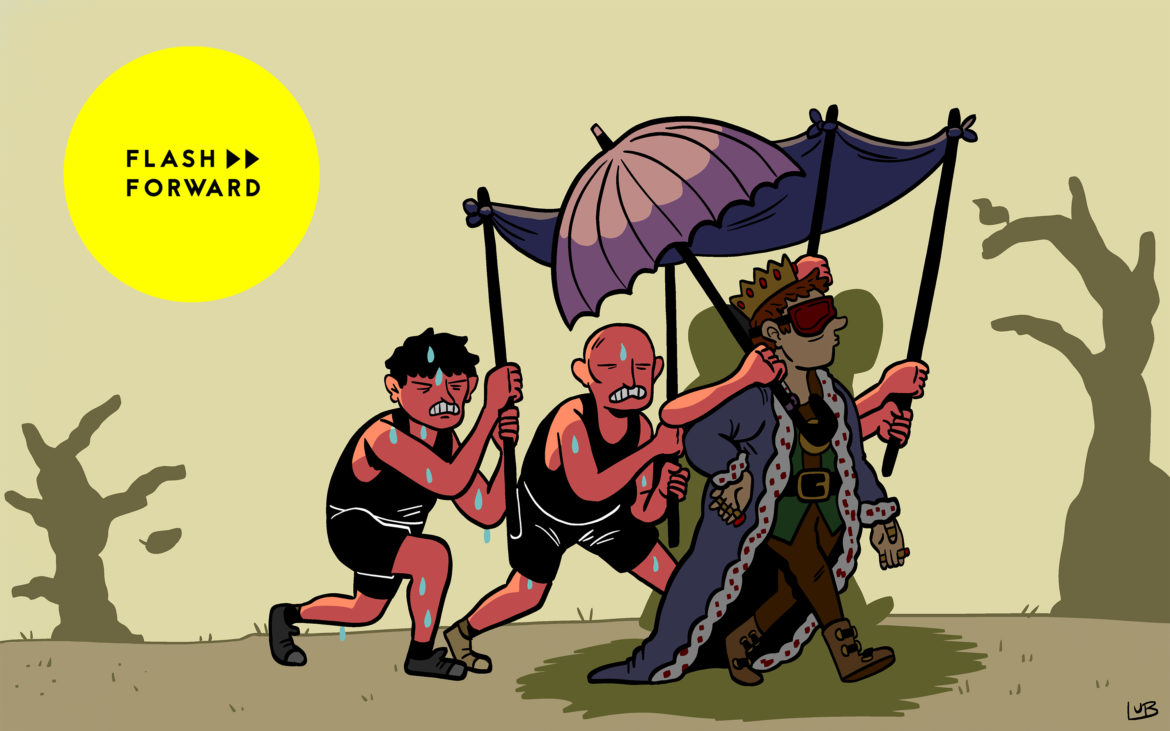
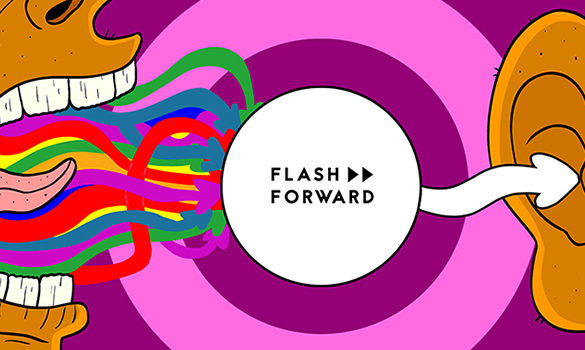
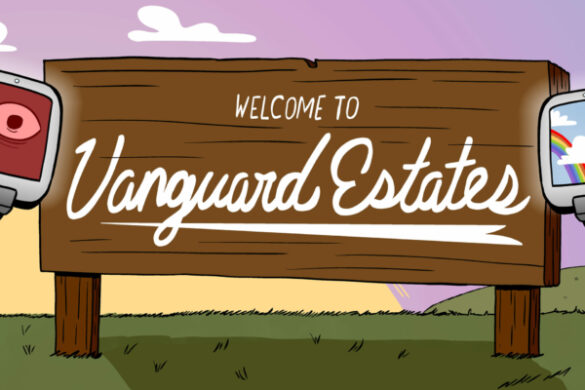
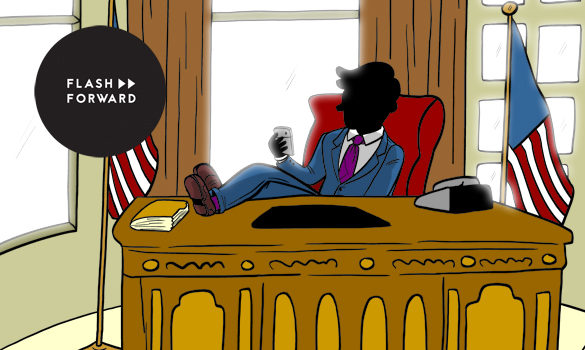
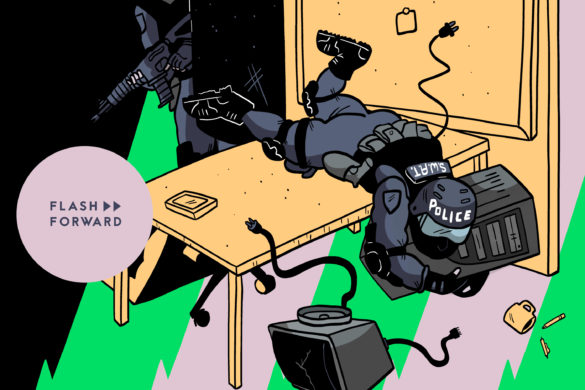
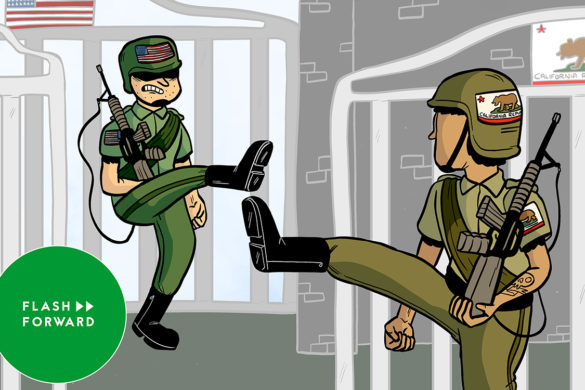
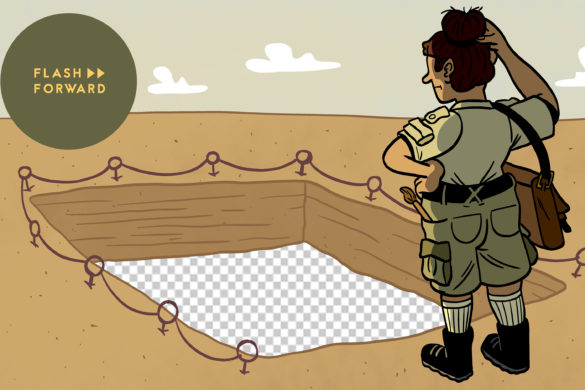
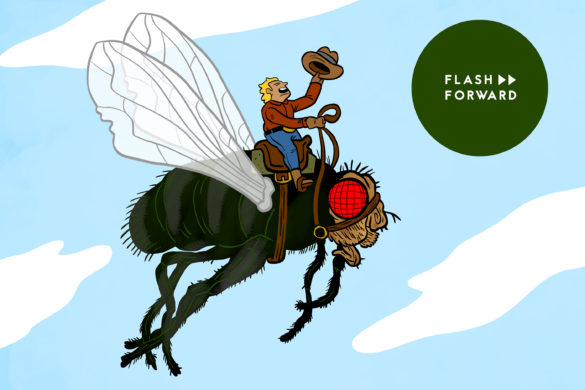
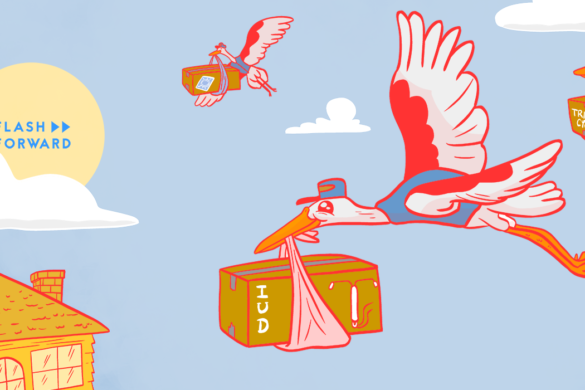
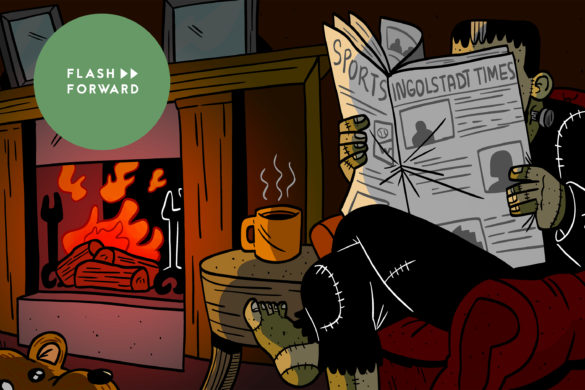
3 comments
Dear Rose,
1st… Your intro made me cry. Thank you.
2nd… I hated Starlink the first time that I read about it.
3rd… You’ve given me another podcast to listen to. Thank you! (The Weirdest Thing I Learned This Week).
[…] هل ستختفي سماء الليل ليعم الضياء؟ وما العيب في ذلك؟ روز تخبرنا. […]
[…] constellation up into orbit around Earth. We talked about these orbiting networks in the episode Goodnight Night, and why they threaten the future of astronomy. Amazon’s version of this is called Kuiper and […]